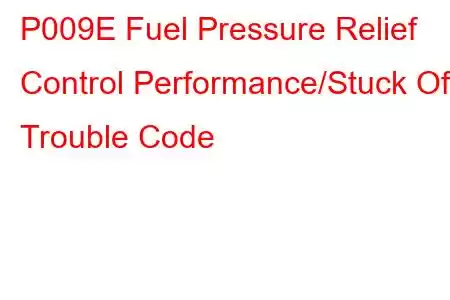P009E Fuel Pressure Relief Control Circuit Performance/Stuck Off
OBD-II Trouble Code Technical Description
Fuel Pressure Relief Control Circuit Performance/Stuck Off
What does that mean?
This generic powertrain diagnostic trouble code (DTC) typically applies to all OBD-II vehicles. That may include but is not limited to vehicles from Dodge, Ram, Chevy, Ford, GMC, Saturn, etc. Although generic, the specific repair steps may vary depending on make/model.
The P009E OBD-II trouble code is one of five possible codes that indicates that the Powertrain Control Module (PCM) has detected a malfunction and with the operation of the Fuel Pressure Relief Control Circuit.
The codes that are associated with Fuel Pressure Relief malfunctions are P009B, P009C, P009D, P009E, and P009F.
The purpose of the Fuel Pressure Relief Control Circuit is to control the amount and pressure of the fuel delivered to the engine to operate properly. The PCM monitors the fuel pressure regulator and opens the fuel pressure relief valve to return excess fuel back to the fuel supply system.
Code P009E is set by the PCM when the Fuel Pressure Relief Control Circuit stuck in the off position or has a performance condition.
What is the severity of this DTC?
The severity of this code is normally moderate based on the specific malfunction.
An example of a fuel pressure relief valve:
What are some of the symptoms of the code?
Symptoms of a P009E engine code may include:
Engine will not start Poor engine performance Check Engine Light illuminated Fuel dripping from tailpipe Increased fuel consumptionWhat are some of the possible causes of the code?
Causes for this code may include:
Defective fuel pump Faulty fuel pressure relief valve Fuel pressure regulator failure Corroded or damaged connector Faulty or damaged wiring Faulty PCMWhat are some P009E troubleshooting steps?
The first step in the troubleshooting process for any malfunction is to research the Technical Service Bulletins (TSB's) for the specific vehicle by year, model and power plant. In some circumstances this can save a lot of time in the long run by pointing you in the right direction.
Locate all of the components associated with the Fuel Pressure Relief Control Circuit. This will include the fuel pump, fuel pressure regulator, fuel pressure relief valve and the PCM on a simplex system. Once these components are located a thorough visual inspection should be performed to check all of the associated wiring and connectors for obvious defects such as scraping, rubbing, bare wires or burn spots.
Fuel Pressure Tests
The appropriate fuel pressure will vary based on the specific engine and the configuration of the fuel supply system. Tech data should be referenced to obtain the correct fuel pressure range and the locations to install a fuel pressure gauge to preform the pressure tests accurately.
Advanced Steps
The advanced steps become very vehicle specific and require the appropriate advanced equipment to perform accurately. These procedures require a digital multi meter and the specific technical references for the vehicle. Voltage requirements will very based of the specific year, model and engine in the vehicle.
Circuit Checks
Voltage requirements will vary based on the specific engine, the Fuel Pressure Relief Control Circuit configuration and the components incorporated. Tech data should be referenced to obtain the correct voltage range for each component.
If this process identifies the absence of a power source or ground, continuity testing may be needed to check the condition of the wiring. Continuity tests are always performed with the power removed from the circuit and the normal readings should be 0 ohms of resistance unless otherwise specified by the technical data. Resistan
Read: 46


